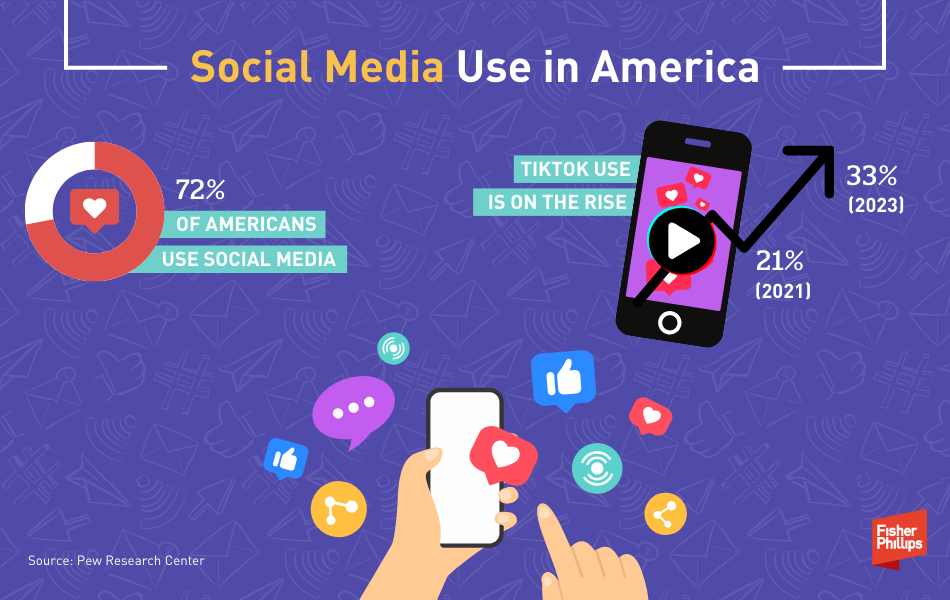4 Social Media Tips for Employers as Workplace TikToks Continue to Go Viral
Insights
10.15.24
The latest TikTok trends encouraging people to post from work have garnered millions of views as employees post videos from their jobs in retail, office, healthcare, and a host of other settings. Many netizens view these TikToks as prime marketing for companies, while others have joined broader discussions about the risks of posting from the workplace. While some employers appreciate the use of social media by their employees to build stronger brands and bolster recruiting efforts, others have responded by firing employees for violating company policies. Posts sent from the workplace might reveal sensitive information, which raises privacy and confidentiality concerns. Moreover, they could be problematic for your organization when employees discuss their bosses and general work experiences — whether positive or negative. So where do you draw the line? As social media use and trends evolve, you may want to regularly review and adjust your guidelines to strike the right balance while also ensuring your policies don’t run afoul of employment and labor laws. Here are four tips for updating your social media policies to reflect this modern era and stay on top of the latest developments.
This Insight was co-authored by Law Clerk Joy Hong (Atlanta).
1. Keep Up with Trends to Be Proactive
In the early days of social media, your policies may have simply prohibited employees from using company equipment to post non-work-related content and required work posts to be business appropriate. Now, companies are leaning towards implementing policies that cover social media use more broadly.
Viral workplace posts have covered a wide range of topics from pay transparency to being overworked to doing the bare minimum. Some feature an employee’s workspace, while others share recordings of sensitive conversations with managers or HR. Some are meant to be funny or satirical, while others are meant to be serious. Moreover, even professional platforms like LinkedIn are becoming inundated with casual, personal posts about family and hobbies outside of work.
Regardless of the specific content, social media trends develop at a rapid pace, and it’s important for your company to stay up to date on them. Not only can this help identify future workplace issues, but it can also ensure your social media policies are revised accordingly.
2. Strike a Balance
Before you decide to curb all TikTok or other social media posts from the workplace, you should recognize that such posts can pay dividends. Employees who are active on social media may be more equipped to understand the social pulse of the company’s customer base. Additionally, allowing employees to contribute to company-sponsored social media posts shows that the company trusts them, which can increase confidence and make employees feel valued.
Social media networking may also help employees collaborate, share ideas, and solve problems. This can lead to better employee engagement and retention. Moreover, utilizing social media in the workplace can make the company more desirable to potential applicants, particularly Gen Z and Millennial job seekers.
Social media is here to stay, and employers should recognize that policies barring its use altogether in the workplace may be unrealistic. In fact, about 72% of respondents to a 2021 Pew Research Center survey said they use some form of social media – and TikTok use has grown since then to 33% (up from 21%). Notably, although younger workers are more likely to be on TikTok, a significant amount of Americans age 30 and older also use the platform.
While not every company can allow on-the-job posts, those with flexibility might want to dedicate resources to creating a mutually beneficial, collaborative policy around social media use in the workplace. For example, allowing employees to share their experiences with your company through social media may promote transparency and provide job seekers with credible information on what it’s really like to work for your business.
3. Address the Potential Pitfalls
While employers may benefit from employees’ on-the-job social media posts, you should also address the potential dangers, including legal and business concerns.
Of the many legal concerns, the most glaring are privacy protections and confidentiality.
- As employees capture authentic moments during the workday for social media posts, they frequently walk around the workplace recording offices, conference rooms, common spaces, the cafeteria, and more. The videos may inadvertently capture confidential information, such as audio of an internal meeting, the image of a client’s name, or a trade secret.
- These confidentiality issues can also arise with employees who work remotely. For example, an employee may take a video of their innovative at-home workspace while a Zoom meeting is in progress or while their computer screen displays proprietary information.
You should also be cognizant of how allowing employees to post on the job can potentially harm your organization’s reputation.
- Some trends on TikTok and other social media platforms attract users who want to be authentic rather than staged, heavily filtered, or otherwise unauthentic. Thus, employees who choose to participate in these trends do not shy away from capturing the “realness” of their job.
- This, in turn, can lead to your employees sharing information that negatively affects the company, such as human resources concerns (including allegations of unprofessional comments made by colleagues), complaints about working conditions, and products liability issues. All of these discussions raise both reputational and legal concerns that you should take into account.
4. Set Realistic Parameters
With these benefits, risks, and (pop) cultural considerations in mind, what should your modern social media policy include?
If you already have a solid employee handbook, a good place to start is by reminding employees that your existing policies still apply when using social media platforms. For example, an equal employment and harassment-prevention policy would cover discriminatory or bullying behavior towards colleagues whether online or in person. You should remind employees who they should contact when they have a workplace concern. Additionally, let employees know that confidentiality policies apply when they share content, so their computer screens and documents should not be visible in the background.
Depending on the nature of your business and your employees’ roles, however, you may want to create a more targeted policy on social media use. For instance, you may have different risks to manage if you encourage employees to engage with your brand, employ a younger workforce, or otherwise have a strong social media presence.
As you likely know, your policy should be in writing and followed consistently. Where to go from there is more complicated. The explosion in social media use has only highlighted how regulating employee speech is difficult, nuanced, and occasionally backfires. But, of course, there are still some best practices. Consider taking these five steps:
- Develop policies in collaboration with legal counsel, HR, technology, communications, and diversity, equity, and inclusion (DEI) teams.Be sure the policy matches the company’s voice and recognize that this is not a one-template-fits-all exercise.
- Use plain language and examples.“Do not share patient x-rays, even if their name is covered” is more helpful than “Posting patient information will subject employees to discipline up to and including termination.”
- Keep up with guidance from the National Labor Relations Board (NLRB). You may be tempted to ban all work-related TikTok postings, but you should recognize that employees have the legal right to discuss their wages, hours, and terms and conditions of employment. Specifically, private sector employees have the right to engage in protected concerted activity under the National Labor Relations Act (NLRA) for purposes of collective bargaining or other mutual aid or protection. This is true in bothunion and nonunion settings. Under Section 7 of the NLRA, concerted activity includes statements made for the purpose of initiating, inducing, or preparing employees for group action, such as discussions about higher wages, changes to work schedules, and job security. So, you’ll want to consult your attorney to ensure your social media policies don’t unintentionally violate federal labor law.
- Confirm applicable state laws.There is a legislative trend to prohibit employers from requiring employees to engage with social media as a condition of employment or even to ask for their social media usernames as part of a job application. You should also note that state laws vary on notice and consent for recordings. Does your state require one-party or two-party consent to record conversations? Compliance can get complicated, so as you develop your policies, you may want to consult legal counsel about the laws that apply in your jurisdiction.
- Develop a plan for consistently responding to policy violations.Two employees violating the same rule in the same way should not be treated differently based on whether they tripped the algorithm and went viral. Relatedly, consider the reputational risk of a too-harsh response – someone who is fired for social media content may likely use the same platforms to discuss their termination.
Conclusion
If you have questions regarding your social media policy, contact your Fisher Phillips attorney or the authors of this Insight. We will continue to monitor developments in this area, so make sure you are subscribed to Fisher Phillips’ Insight System to get the most up-to-date information.
This Insight was co-authored by Law Clerk Joy Hong (Atlanta).
Related People
-
- Terri R. Stewart
- Regional Managing Partner

